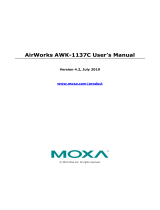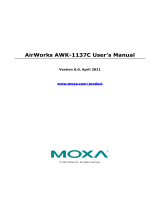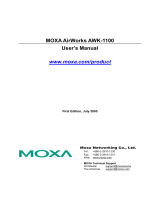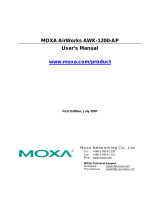Page is loading ...

P/N: 1802011370016
*1802011370016*
AWK-1137C
Quick Installation Guide
Moxa AirWorks
Edition 7.0, October 2018
Technical Support Contact Information
www.moxa.com/support
Moxa Americas:
Toll
-free: 1-888-669-2872
Tel:
1-714-528-6777
Fax:
1-714-528-6778
Moxa China (Shanghai office):
Toll
-free: 800-820-5036
Tel:
+86-21-5258-9955
Fax:
+86-21-5258-5505
Moxa Europe:
Tel:
+49-89-3 70 03 99-0
Fax:
+49-89-3 70 03 99-99
Moxa Asia-Pacific:
Tel:
+886-2-8919-1230
Fax:
+886-2-8919-1231
Moxa India:
Tel:
+91-80-4172-9088
Fax:
+91-80-4132-1045
2018 Moxa Inc. All rights reserved.

- 2 -
Overview
The AWK-1137C industrial Wi-Fi client meets the growing need for
faster data transmission speeds and wider coverage by supporting IEEE
802.11n technology with a net data rate of up to 300 Mbps. The AWK-
1137C combines two adjacent 20 MHz channels into a single 40 MHz
channel to deliver a potent combination of greater reliability and more
bandwidth. The AWK-1137C can operate on either the 2.4 GHz or the
5 GHz band and is backward compatible with existing 802.11a/b/g
deployments.
Hardware Setup
This section covers the hardware setup for the AWK-1137C.
Package Checklist
Before installing the AWK-1137C, verify that the package contains the
following items. If any of these items is missing or damaged, please
contact your customer service representative for assistance.
• 1 AWK-1137C wireless client
• 2 2.4/5 GHz omni-directional antennas: ANT-WDB-ARM-0202
• DIN-rail kit
• Quick installation guide (printed)
• Warranty card

- 3 -
Panel Layout of the AWK-1137C
1. System LEDs: SYS, WLAN,
LAN1, LAN2, and SERIAL
2. LAN1: 10/100 BaseT(X) RJ45
port
3. LAN2: 10/100 BaseT(X) RJ45
port
4. RS-232/422/485 DB9 serial
port
5. 3-pin terminal block (ground/-
/+)
6. M3 screw holes for antenna
bracket
7. Antenna B RP-SMA
8. Antenna A RP-SMA

- 4 -
9. 3-pin maintenance port for
engineers
10.
Reset button
11.
Screw holes for DIN-rail
mounting kit
12.
Screw holes for wall-mounting
kit

- 5 -
Mounting Dimensions
Unit = mm (inch)
DIN-Rail Mounting
When shipped, the metal DIN-rail mounting kit is fixed to the back
panel of the AWK-1137C. Mount the AWK-1137C on the corrosion-free
mounting rail that adheres to the EN 60715 standard.
STEP 1:
Insert the upper lip of
the DIN-
rail kit into the mounting rail.
STEP 2:
Press the AWK
-1137C towards the
mounting rail until it snaps into place.

- 6 -
To remove the AWK-1137C from the DIN rail, do the following:
STEP 1:
Pull down the latch on the DIN
-
rail kit with a screwdriver.
STEP 2 & 3:
Slightly pull the
AWK
-1137C forward and lift it
up to remove it from the
mounting rail.
Wall Mounting (Optional)
For some applications, it may be more convenient to mount the AWK-
1137C to a wall, as illustrated below:
STEP 1:
Remove the aluminum
DIN
-rail attachment
plate from the
AWK-
1137C, and then attach
the wall
-mounting
plates with M3 screws,
as shown in the
adja
cent diagrams.
STEP 2:
Mounting the
AWK-1137C to a wall requires two
screws. Use
the AWK-1137C device, with wall-
mount
ing plates attached, as a guide to mark the
correct locations of the
two screws. The heads of the
screws should be less than 6.0 mm in diameter, and
the
shafts should be less than 3.5 mm in diameter,
as shown in the figure on the right.
Do not drive the screws in all the way—leave a space of about 2 mm to
allow room for sliding the wall-mounting panel between the wall and
the screws.
NOTE
Test the screw head and shank size by inserting the screws into
one of the keyhole
-shaped apertures of the wall-mounting
plates before they are fixed to the wall.

- 7 -
STEP 3a:
Once the screws are fixed into the
wall, insert the
two screw heads
through the large opening of the
keyhole
-shaped apertures, and then
slide the
AWK-1137C downwards, as
indicated to the right. Tighten the
two
screws for added stability.
STEP 3b:
Alternatively, insert four screws
directly through the AWK
-1137C into
the wall.
WARNING
•
This equipment is intended to be used in a Restricted
Access Location, such as a dedicated computer room
where
only authorized service personnel or
users can gain access.
Such personnel must be instructed about the fact that the
metal chassis of the equipment is extremely hot and may
cause burns.
•
Service personnel or users have to pay special attention
and take special precautions before handling this
equipment.
•
Only authorized, well-trained professionals should be
allowed to access the Restricted Access Location. Access
should be controlled by the authority responsible for the
location with a lock and key or a security identity system.
•
External metal parts are hot!! Pay special attention or
use special protection before handling this equipment.
Wiring Requirements
WARNING
Safety First!
Be sure to disconnect the power cord before installing and/or
wiring your M
oxa AWK-1137C.
Calculate the maximum possible current in each power wire
and common wire. Observe all electrical codes that dictate the
maximum current allowed for each wire size. If the current
goes above the maximum ratings, the wiring could overheat,
causing serious damage to your equipment.

- 8 -
You should also pay attention to the following items:
• Use separate paths to route wiring for power and devices. If power
wiring and device wiring paths must cross, make sure the wires are
perpendicular at the intersection point.
NOTE
Do not run signal or communications wiring and power wiring in
the same wire conduit. To avoid interference, wires with
different signal characteristics should be routed separately.
• You can use the type of signal transmitted through a wire to
determine which wires should be kept separate. The rule of thumb
is that wiring with similar electrical characteristics can be bundled
together.
• Keep input wiring and output wiring separate.
• It is strongly advised that you label wiring to all devices in the
system when necessary.
ATTENTION
This product is intended to be supplied by a UL
-listed power
adapter suitable for use at
a Thermom
echanical Analysis (TMA)
of
75 degree Celsius, which output meets SELV circuit and LPS
standards;
output rated 9 to 30 VDC, 1.3A min. or 24 VDC,
0.49A min.
ATTENTION
Make sure
the external power adapter (includes power cords
and plug assemblies)
provided with the unit is certified and
suitable for use in your country.
Grounding the Moxa AWK-1137C
Grounding and wire routing help limit the effects of noise due to
electromagnetic interference (EMI). Run the ground connection from
the ground screw to the grounding surface prior to connecting devices.
ATTENTION
This product is intended to be mounted to a well
-grounded
mounting surface, such as a metal panel.
There must be no
electrical potential difference between any two grounding
points
; otherwise, there is a risk that the device could be
destroyed.

- 9 -
Installing Cable Extended Antennas for Outdoor Applications
If the antenna or the AWK device is installed outdoors or in an open-air
setting, proper lightning protection is required to prevent direct
lightning strikes on the AWK device. In order to prevent coupling
currents from nearby lightning strikes, a lightning arrester should be
installed as part of your antenna system. Ground the device, antenna,
as well as the arrester properly to provide maximum outdoor protection
for the device.
Arrester Accessories
• SA-NMNF-01: Surge arrester, N-type (male) to N-type (female)
• SA-NFNF-01: Surge arrester, N-type (female) to N-type (female)
Wiring the Power Input
The 3-contact terminal block connector on the AWK-1137C’s side panel
is used for the AWK-1137C’s DC input. The top and front views of the
terminal block connector are shown below:
STEP 1:
Insert the negative/positive DC wires into the
V
-/V+ terminals.
STEP 2:
To keep the DC wires from pulling
loose, use a
small flat
-blade screwdriver to tighten the wire-
clamp screws on
the front of the terminal block
connector.
STEP 3:
Insert the plastic terminal block connector
prongs into the terminal block receptor, which
is
located on the AWK-1137C’s side panel.

- 10 -
NOTE
Input Terminal Block (CN1) is suitable for wire size range of 12-
28 AWG (3.31
-0.0804 mm²) and a torque value of 4.5 lb-in
(0.51 Nm)
ATTENTION
If the
AWK-1137C
is connected to a motor or other similar type
of equipment, be sure to use power isolation protection. Before
connecting the
AWK-1137C
to the DC power inputs, make sure
the DC power source voltage is stable.
Using the Reset Button
The Reset button is used to load the factory default settings. Use a
pointed object to hold the Reset button down for five seconds to load
the factory defaults.
Activating AeroMag Function
Push the Reset Button five times to activate AeroMag. To deactivate it
again, push the Reset Button three times.
Installing the Antenna-Locking Clamp
Use the antenna-locking clamp to secure the antennas to the AWK-
1137C for added stability when you install the device in a high-vibration
environment.
STEP 1:
Slide the
locking clamps through
the
antenna ports.
STEP 2:
Use s
crews to fix the clamps to the
side
panel of the AWK-1137C as
shown below:
Communication Connections
10/100BaseT(X) Ethernet Port Connection
The 10/100BaseT(X) ports located on the AWK-1137C’s front panel are
used to connect to Ethernet-enabled devices.

- 11 -
The pinouts for both the MDI (NIC-type) and MDI-X (HUB/switch-type)
ports as shown below:
MDI Port Pinouts
MDI-X Port Pinouts
8-pin RJ45
Pin
Signal
1
Tx+
2
Tx-
3
Rx+
6
Rx-
Pin
Signal
1
Rx+
2
Rx-
3
Tx+
6
Tx-
RS-232/422/485 Serial Port
The AWK-1137C has 1 RS-232/422/485 serial port with DB9 connector
for serial-to-WLAN connectivity. The pin assignments for the serial
ports are shown below:
Pin RS-232
RS-422/485
(4W)
RS-485
(2W)
1
DCD
TxD-(A)
–
2
RxD
TxD+(B)
–
3
TxD
RxD+(B)
Data+(B)
4
DTR
RxD-(A)
Data-(A)
5
GND
GND
GND
6
DSR
–
–
7
RTS
–
–
8
CTS
–
–
9
–
–
–
LED Indicators
The front and side panel of the Moxa AWK-1137C contains several LED
indicators. The function of each LED is described in the table below:
LED
Color
State
Description
SYS
Green
On
System start up complete and the
system is in operation
Blinking +
Beeps
(Interval: 1
second)
Device has been located by the
Wireless Search Utility
Red
On
System is booting or a system
booting error has occurred
Blinking
(Interval: 0.5
second)
IP address conflict
Blinking
(Interval: 1
second)
Cannot obtain an IP address from the
DHCP server
WLAN
Green
On
(RSSI > 35)
WLAN interface has connected
Blinking
Data communication via WLAN
Amber
On
(RSSI < 35)
WLAN interface has connected
Blinking
Data communication via WLAN

- 12 -
LED
Color
State
Description
LAN1
Green
On
Ethernet LAN 1 interface has
connected
Blinking
Data communication via Ethernet
LAN 1
LAN2
Green
On
Ethernet LAN 2 interface has
connected
Blinking
Data communication via Ethernet
LAN 2
Serial
Amber
Blinking
Data Transmission via serial data
port
Specifications
Power Input
9 to 30 VDC
Power
Consumption
11.7 W
Operating
Temperature
Standard Models: 0 to 60°C (32 to 140°F)
Wide Temp. Models: -40 to 75°C (-40 to 167°F)
Storage
Temperature
-40 to 85°C (-40 to 185°F)
ATTENTION
•
The AWK-1137C is NOT a portable mobile device and
should be located at least 20 cm away from the human
body.
•
The AWK-1137C is NOT designed for the general public. A
well-trained technician is required to deploy AWK-1137Cs
and safely establish a wireless network.
ATTENTION
Use the antennas correctly: The 2.4 GHz antennas are needed
when the
AWK-1137C operates in IEEE 802.11b/g/n. The 5
GHz antennas are needed for operation in IEEE802.11a/n.
Make sure that the antennas are installed in a safe area, which
is covered by a lightning protection or surge arrest system.
ATTENTION
This device complies with part 15 of the FCC Rules.
The
o
peration of this device is subject to the following conditions:
1. This device must not cause harmful interference.
2. This device must accept any interference received,
including interference that may cause undesired
operations.

- 13 -
ATTENTION
Do not locate the antenna near overhead power lines or other
electric light or power circuits, or where it can come into
contact with such circuits. When installing the antenna, take
extreme care not to come into contact with such circuits,
because they may cause serious injury or death. For proper
installation and grounding of the antenna, refer to national and
local co
des (for example, U.S.: NFPA 70; National Electrical
Code (NEC) Ar
ticle 810; Canada: Canadian Electrical Code,
Section 54).
WARNING
Este equipamento não tem direito à proteção contra
interferência prejudicial e não pode causar interferência em
sistemas devidamente autorizados.
This
equipment has no right to protection against harmful
interference and cannot cause interference in duly authorized
systems.
NOTE
For installation flexibility, you may select either antenna A or
antenna
B on the top panel. Make sure the antenna connection
matches the antenna
s configured in the AWK-1137C web
interface.
To protect the connectors and RF module, all radio ports should
be terminated by either an antenna or a terminator.
We
strongly recommend using resistive terminators for terminating
the unused antenna ports.
Federal Communications Commission
Interference Statement
This equipment has been tested and found to comply with the limits for
a Class B digital device, pursuant to part 15 of the FCC Rules. These
limits are designed to provide reasonable protection against harmful
interference in a residential installation. This equipment generates,
uses, and can radiate radio frequency energy and, if not installed and
used in accordance with the instructions, may cause harmful
interference to radio communications. However, there is no guarantee
that interference will not occur in a particular installation.

- 14 -
If this equipment does cause harmful interference to radio or television
reception, which can be determined by turning the equipment off and
on, the user is encouraged to try to correct the interference by one or
more of the following measures:
• Reorient or relocate the receiving antenna.
• Increase the separation between the equipment and receiver.
• Connect the equipment into an outlet on a circuit different from
that to which the receiver is connected.
• Consult the dealer or an experienced radio/ TV technician for help.
ATTENTION
Any changes or modifications not expressly approved
in the
g
uaranty for this device could void the user's authority to
operate the equipment.
WARNING
RF exposure
:
This equipment must be installed and operated in accordance
with provided instructions and the antenna(s) used for this
transmitter must be installed to provide a separation distance
of at least 20 cm
from all persons and must not be co-located
or operating in conjunction with any other antenna or
t
ransmitter. End-users and installers must be provided with
antenna installation instructions and transmitter
operating
conditions for satisfying RF exposure
compliance.
This radio transmitter FCCID: SLE
-1137C has been approved
by FCC to operate with the
antenna types listed below with the
maximum permissible gain and required antenna
impedance
for each antenna type indicated. Antenna types not included in
this
list, having a gain greater than the maximum gain
indicated for that type, are strictly
prohibited for use with this
device.

- 15 -
Software Setup
This section covers the software setup for AWK models in general.
How to Access the AWK
Before installing the AWK device (AWK), make sure that all items in the
package checklist are provided in the product box. You will also need
access to a notebook computer or PC equipped with an Ethernet port.
• Step 1: Select a suitable power source and plug in the AWK.
The AWK can be powered by DC power ranging from 9 VDC to 30
VDC.
• Step 2: Connect the AWK to the notebook or PC via the
AWK’s LAN port.
The LED indicator on the AWK’s LAN port will light up when a
connection is established.
NOTE
If you are using an Ethernet-to-USB adapter, follow the
instructions in the user’s manual provided with the adapter.
• Step 3: Set up the computer’s IP address
Choose an IP address for the computer that is on the same subnet
as the AWK. Since the AWK’s default IP address is
192.168.127.253, and the subnet mask is 255.255.255.0, set
the IP address to 192.168.127.xxx, where xxx is a value between
1 and 252.
• Step 4: Access the homepage of the AWK.
Open your computer’s web browser and type
http://192.168.127.253 in the address field to access the AWK’s
homepage. Log in using the following default username and
password:
Default Username: admin
Default Password: moxa
Click the Login button to access the homepage of the AWK device.
First-Time Quick Configuration
After successfully accessing the AWK, refer to the appropriate
subsection below to quickly set up a wireless network.
NOTE
Ensure that there are no IP address
conflicts when you
configure more than one AWK on the same subnet.

- 16 -
Point-to-Multipoint Scenario (Client Mode)
Configuring the AWK as a Client
• Step 1: Set the operation mode of the AWK to Client mode.
Go to Wireless LAN Setup Operation Mode, select Client and
click Submit to apply the change.
NOTE
The default operation mode for the AWK is Client.
• Step 2: Link to an existing SSID.
Go to Wireless LAN Setup WLAN Basic WLAN Setup and
click Site Survey to select an existing SSID, or directly enter an
existing SSID in the text field.
The default SSID is MOXA.
• Step 3: Set the RF type and Channel settings for the AWK.
On the Wireless LAN Setup WLAN Basic WLAN Setup
page, edit the RF type and Channel settings.
Click Submit to apply the changes, and restart the AWK in client
mode to complete the configuration process.

- 17 -
Point-to-Point Scenario (Slave mode)
Configuring the AWK as a Slave
• Step 1: Set the operation mode of the AWK to Slave mode.
Go to Wireless LAN Setup Operation Mode, set the operation
mode to Slave, and then click Submit to apply the change.
• Step 2: Link to an existing SSID.
Go to Wireless LAN Setup WLAN Basic WLAN Setup and
click Site Survey to select an existing SSID,
or directly enter an
existing SSID in the text field
.
• Step 3: Set the RF type for the AWK.
On the Wireless LAN Setup WLAN Basic WLAN Setup
page edit the RF type setting.
Click Submit to apply the changes, and restart the AWK in slave
mode to complete the configuration process
/





